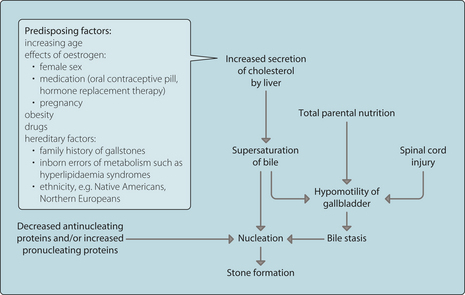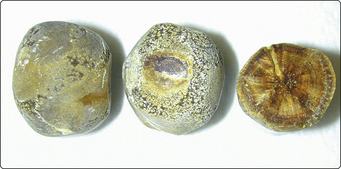Chapter 49 Gallstones
Pathogenesis
Cholesterol stones account for the majority of gallstones in industrialized countries, whereas they are uncommon in non-industrialized countries. The pathophysiology of their formation is summarized in Fig. 3.49.1. Cholesterol dissolves in bile through the detergent actions of lecithin and bile salts. If there is an excess of cholesterol, the solution becomes supersaturated and crystals of cholesterol monohydrate may precipitate if there is a nucleus on which they can begin to grow. Anything that acts as a substrate for crystal growth can act as a nucleus, for example a tiny crystal that forms spontaneously or a particle of mucus. The bile normally contains proteins that tend to inhibit nucleation (antinucleating proteins) and protect against the risk of crystal formation if the bile becomes supersaturated.
Morphologically, cholesterol stones are yellow and their crystalline structure is revealed on examination of a cut surface (Fig. 3.49.2). They tend to be hard and can grow to several centimetres in diameter. Pure cholesterol stones are unusual; most of them also contain some bilirubin and calcium salts. Cholesterol stones with a high proportion of other ingredients are sometimes called mixed stones. In approximately 10% of patients, they contain sufficient calcium to make them radio-opaque to X-rays. Whether calcified or not, gallstones are detectable by ultrasound.
< div class='tao-gold-member'>
Stay updated, free articles. Join our Telegram channel

Full access? Get Clinical Tree








